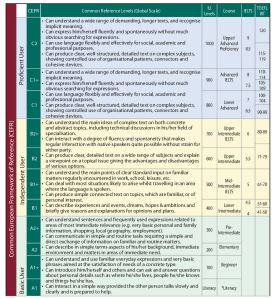As teachers, we need to know a way to specify what our learners are able to do at certain levels, how these levels can guide our teaching and the way we select course books and resources. In short, we need a common language by which we can describe language learning, teaching, and assessment.
In most countries there is general agreement that language learning can be organized into three levels: basic/beginner, intermediate, and advanced.
But, what you mean by intermediate. What is an intermediate level? What does intermediate mean to you as a teacher and to your learners? What does intermediate refer to? To the amount of vocabulary, to the grammar items, to how a learner communicates or at what level understands. Consider how you would describe to a learner what you mean by intermediate. How can we assess a learner’s achievement at an intermediate level if we don’t define exactly what we mean by intermediate? …
Furthermore, levels can mean different things among different institutions and in different countries. Can we directly compare the proficiency level of an advanced English student to that of an advanced Spanish student? …
How do we establish international standards for learning, teaching, and assessment for all modern European languages?
The answers to all this questions is the CEF. The Common European Framework of Reference for Languages(CEF): Learning, Teaching, Assessment published by the Council of Europe (Language Policy Division ) in 2001.
The Common European Framework describes what a learner can do at six specific levels: from A1 to C2:
- Basic User (A1 and A2)
- Independent User (B1and B2)
- Proficient User (C1 and C2)
For each level, the full CEF document complements this by describing in depth:
- Competencies necessary for effective communication.
- Skills and knowledge related to language learning and competencies.
- Situations (people, place, time, organization, etc.) and contexts (study, work, social, tourism, etc.) in which communication takes place.
Common reference levels are based on statements of what a learner can do at each level. The Global Scale is based on a set of statements that describe what a learner can do. The “can do” statements are always positive: they describe what a learner is able to do, not what a learner cannot do or does wrong.
The following table describes each of the six levels of the Global Scale.
However, the CEF is more than the Global Scale. The CEF goes further by breaking down the
Global Scale into more descriptive scales covering three areas of communication:
- Understanding (Listening and Reading)
- Speaking (Spoken Interaction and Spoken Production)
- Writing
The CEF deliberately does not refer to grammar or structures. It is designed to describe how language users communicate and how they understand written and spoken texts. As it is used to describe and compare European languages, we cannot hope to provide a detailed list of grammar structures.
In its own words, the CEF “provides a common basis for the elaboration of language syllabuses, curriculum guidelines, examinations, textbooks, etc.” (CEF: 2001: 1)
Links:
Niveles de competencia lingüística
External links:
http://en.wikipedia.org/wiki/Common_European_Framework_of_Reference_for_Languages
http://www.cambridgeesol.org/about/standards/can-do.html
http://www.examenglish.com/CEFR/cefr.php
Jimenez, Carlos César (2011). El Marco Europeo Común de Referencia para las Lenguas y la comprensión teórica del conocimiento del lenguaje: exploración de una normatividad flexible para emprender acciones educativas



One thought on “The Common European Framework”